- Home
- Introduction
- Website News
- Postscript Magazines
- British History
- Company History
- British Products
- British History National Cash Register Co. Ltd., 1896 - 1900
- NCR Films
- NCR Vintage Products
- Divisions
- NCR Newscast Tapes.
- Personalities
- The National Cash Register Company Ltd. 1896-1900
- Circuit News - Field Engineering
- Patterson Obituary
- Vintage Cash Register Service Aids2
1903 The New Tottenham Court Road Office
The move to the new office at 223,224,225 and 226 Tottenham Court Road, London, was planned for 15th November 1903 but delayed until the 1st January 1904.
This building was to be the Home of NCR Great Britain for 33 years until the need for a larger building prompted the building of Marylebone Road.
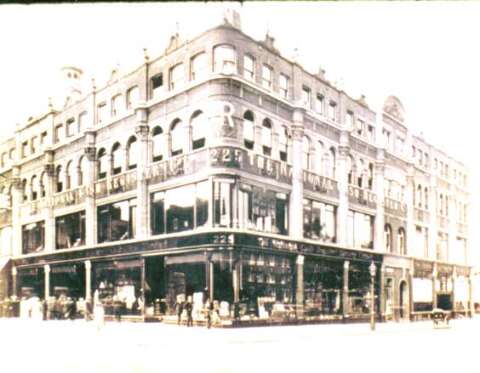
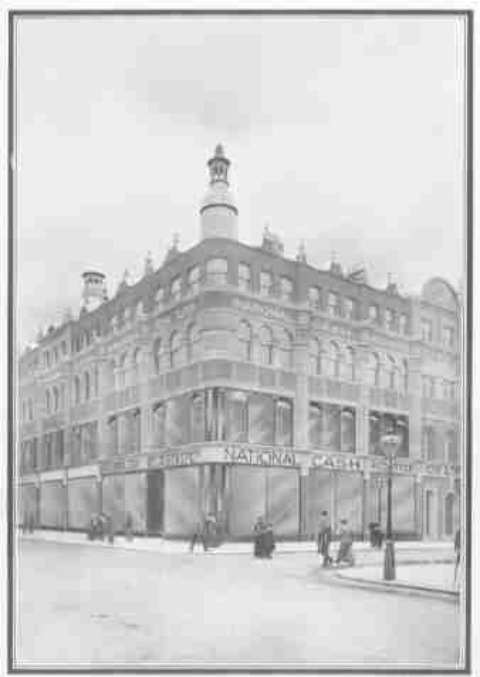
Layout
The foregoing two little pictures give the front and back elevation respectively, of the whole building, and are very interesting, as they show at a glance the location of each department, Altogether we have good reason to be proud of our handsome new building, giving us as it does, three times the floor space we had at our old premises, besides being so much more convenient in numberless ways.
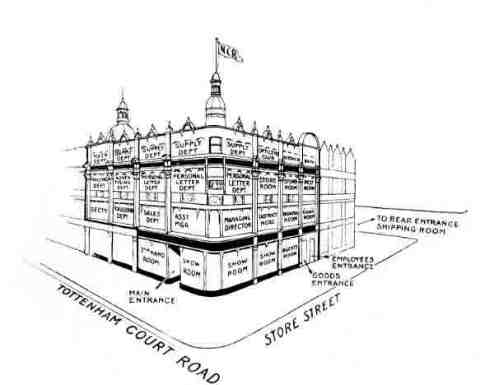
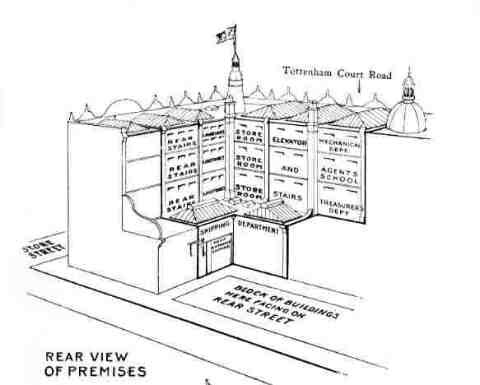
One great advantage, which our photographs are unable to show, is that with our spacious hack-yard we are able to load and unload vans very much more easily and quickly than we could do at our Oxford Street premises
The New Machine Showroom
from The British NCR 10 March 1904
We take pride in illustrating our new premises, into which we moved the first of the year(1904) Everything is now fully organised and working to the best advantage. The benefit of the change is greatly felt, all departments now having the necessary space at their disposal. It is unnecessary in this connection to refer to the expense which has been incurred, except as showing the great confidence which the Company has in the future of the business in this country.
An illustration of the exterior of the building will be found upon the cover of this issue, and on the following pages we show some of the principal departments.
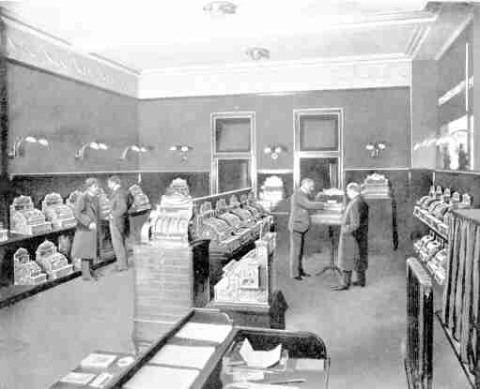
There is very little question that our Showroom is now one of the finest in London, if not the finest, devoted to the exhibition of a speciality. It is of such ample proportions that we have been able to put in a handsome centre-piece in order to show a still greater line of Registers or to enable two Salesmen to take P.P.'s up the line simultaneously without clashing in any way.
Referring to our illustration, it will be seen that demonstrating rooms are provided at the rear, and there is also an office for the chief Salesman.
The showroom is 36 feet in length and 22 feet in width. Its area is therefore nearly 500 square feet.
Photography has its limitations, and although we have made several attempts to get a picture of our Showroom which would give a proper idea of its size and equipment, we have not been able to get quite what we wanted.
The Showroom is most handsomely fitted throughout. The lofty ceiling is ornamented with three flush Electroliers, and several swan-neck Electric Light holders of graceful design are fitted at intervals around the walls. In all this room contains 88 electric lights, which of course give a very brilliant illumination at night time.
The scheme of decoration is rich and effective, without being unduly ornate. The floor is covered with a handsome parquet pattern of Linoleum. The dado of the walls is of dark green plush, while the upper portion is cream coloured. The shelves upon which the Registers stand are handsomely fitted with green velvet and solid brass rails, and give a very fine appearance to the room.
There is also a very fine centre-piece, upon which a large number of Registers stand. We are thus enabled to have an exceedingly long line of Registers on view, and the advantage of having these machines at command when demonstrating to P.P.'s is very great.
Secondhand Showroom
A feature of the Company's policy is to head off second-hand competition, and we illustrate the " Second-hand Showroom," in which are exhibited all grades of second-hand Registers and also a line of "Shop-worn" Registers. It is a great advantage to have these arranged as a separate department as it enables a Salesman to demonstrate either line he pleases with much greater facility.
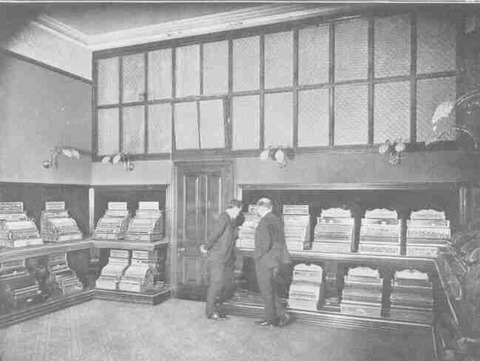
The photograph only shows a portion of the room. This department is fitted in much the same way as the main Showroom, and is in fact uniform with it in the scheme of decoration. Being fitted with handsome velvet and brass shelves, and being itself of ample dimensions, it enables us to have at hand a varied selection of second-hand and shop-worn Registers to show to intending purchasers.
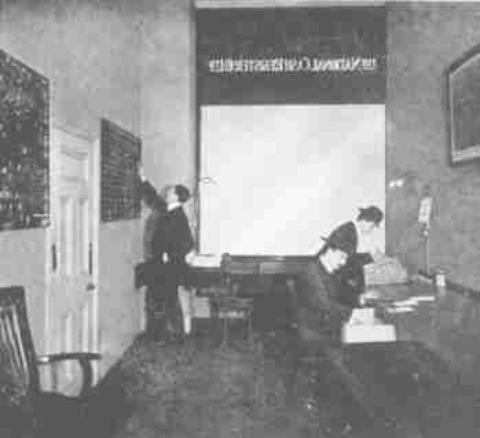
A comfortable room has been provided for the use of the London Sales Agents and Salesmen, known as the "Agents' Room." Desks around the walls have been provided, and in this room will be seen from our illustration the blackboard upon which are indicated from day to day the records made by the London Selling Force. This board has proved to be of the greatest interest.
Agents Room
We have now at our disposal very much greater Basement accommodation than we had in our old quarters, and the benefit of this is very apparent. It is now possible to ship Registers with much greater facility and speed than ever before, and every member of the organisation will feel the advantage of this. Every convenience is provided for the speedy and accurate testing of Registers before despatch.
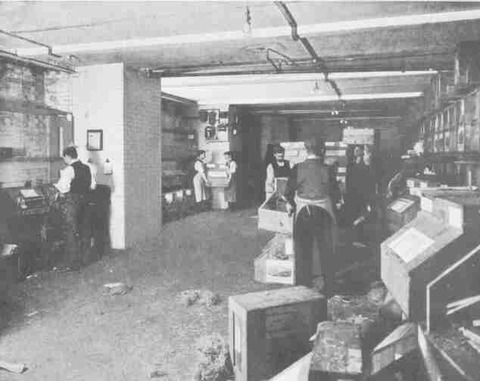
Reaching the First Floor by the Otis Electric Elevator, we obtain the view along the Corridor of the principal First-Floor Offices seen in the photograph.
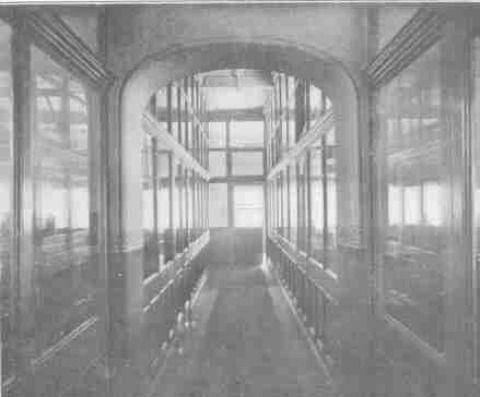
It will be noticed how conveniently the offices on this floor are situated, the Treasurer's Dept., Secretary's Dept., Collection Dept., Vice-President's, Sales' Dept. Chief Clerk, Assistant Manager and Manager of Agencies, Managing Director, Board Room, District Managers and Stenographers offices all communicating by means of the same Corridor.
Managing Directors' Room.
Here we see Mr. Saxe seated at his desk conferring with Assistant-Manager Mitchell.
All these First-Floor Offices are fitted with large windows and large glass partitions, giving an abundance of light, and rendering it easy to see from any one office into many other offices on that Floor. This is an enormous advantage.
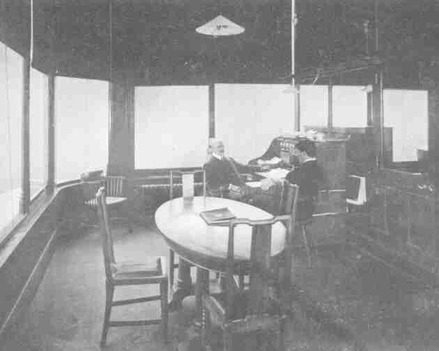
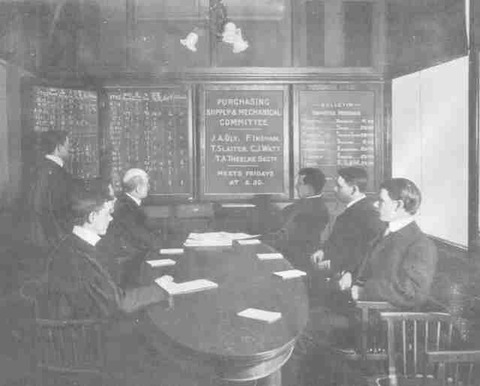
Board Room.
This illustration shows the Supply and Purchasing Committee sitting. The Folding Blackboards containing the agenda before the meeting, will be seen upon the wall. Each committee is provided with its own Folding Blackboard, after the plan in vogue at the Dayton Factory, and great benefit is already derived from this system.
Personal Letter Department
Mounting to the second floor one comes to the Personal Letter Department. At our old premises this Department was very much cramped. The addressing of Hustler Envelopes, sending Out Personal Letters in large quantities, means a very great deal of work, and keeps busy quite a large staff of young women. We had not space at our disposal to employ all the help we really needed. This Department now occupies two large rooms connected by an archway, but owing to the shape of the room and the level from which the photo-graph had to be taken, our view gives the impression that the rooms are somewhat closely filled. As a matter of fact there is ample room between each employee and the next, enabling them to work in much greater comfort than heretofore.
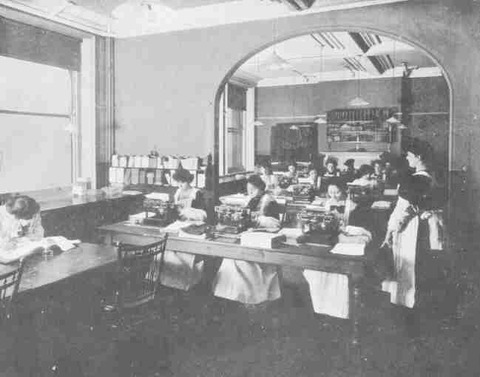
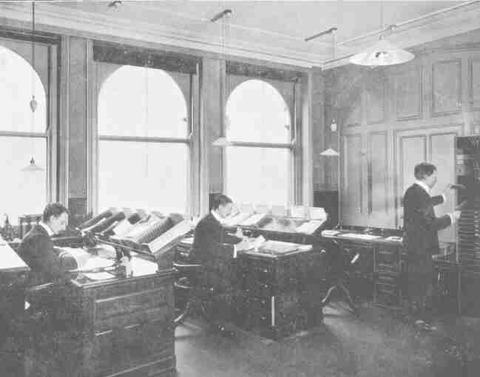
Advertising Department
Next to the Personal Letter Department is situated the advertising department, where our various pieces of Advertising Matter are prepared. Advertising is to be even more of a special feature of the Company's work this year than heretofore, and it is to be hoped that the Selling Force will take full advantage of all the time and trouble, to say nothing of the expense, of getting out all our various pamphlets, advertisements, etc.
Mailing Department.
We next reach the Mailing Department, which undertakes the forwarding of all letters, filing of correspondence, etc. This Department has now been thoroughly organised, and carries out its work in a very efficient manner, dealing as it does with many hundreds of letters to and from all departments, daily. The main Exchange Telephone is also located in this Department, with an extension to the First Floor. In addition to the Exchange Telephone, every department is able to communicate with any other department in the building by our own private system of telephones, which of course saves an immense amount of time and trouble in the detail work of the business.
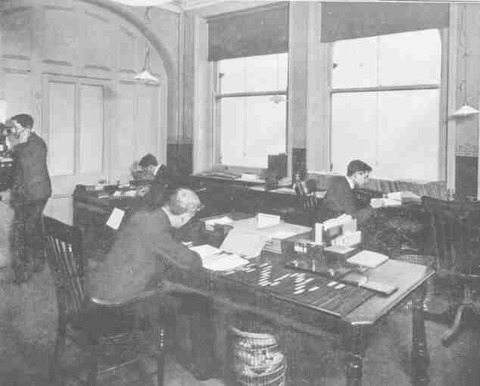
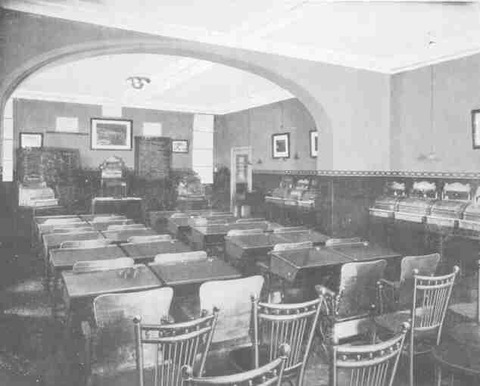
Still on the second floor we have the Agents' Training School and Convention Hall, as shown elsewhere. This is a very fine room-capable of seating 60 men comfortably. Our photograph shows the room empty, with its desks and seats specially imported from the United States for the use of the Members of the Training School. In this room also is kept a very complete line of Registers for the instruction of the School, and altogether our Salesmen and Agents have every convenience for study in this commodious and pleasant School-room.
Supply Department
On the third floor we have the Supply Department, which is the largest department in the whole building. It occupies three large rooms connected by archways, but owing to this fact it is impossible to show a comprehensive view of the Department. Here, however, are handled the stocks of Advertising Matter, in addition to Register supplies and repair parts, and a very great amount of work is transacted by this Department.
Mechanical Department
On the same floor we have the Mechanical Department. Our photograph, however, only shows one wing of this Department, owing to its shape. It gives a good idea of the favourable conditions under which our mechanics work, with regard to space, light, etc., in testing and repairing Registers.
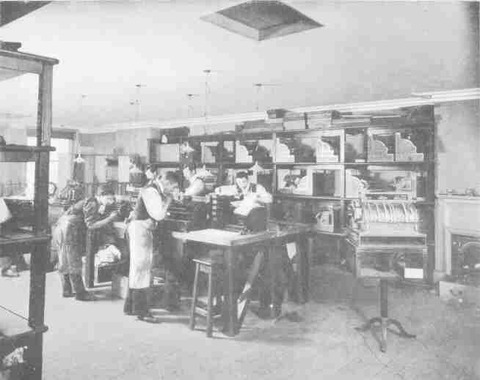
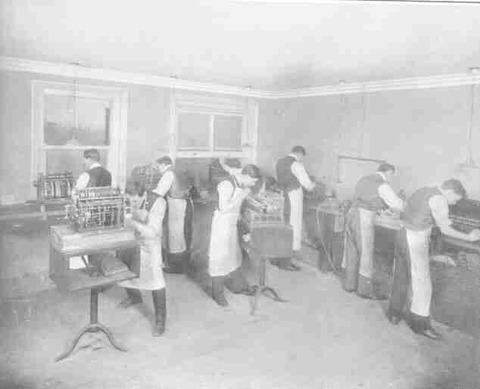
We give a view of a portion of the mechanical department. This shop is in the shape of a letter L" so that it is obviously impossible to get one photograph of the whole of its extent. The part shown represents perhaps one-fifth of its total area. Here all second-hand and shop-worn Registers are thoroughly overhauled before being sent out. The mechanical department is spacious, well-ventilated and provided with ample light. There is also plenty of bench room, and every convenience and appliance at hand for the expeditious handling of mechanical work.
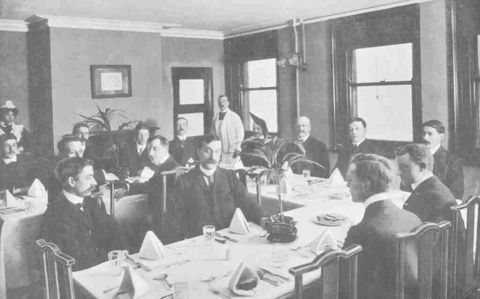
Officer's Club
On the Third Floor also we have the Officers' Club, as shown in our illustration. Here the heads of the Departments with their assistants, meet for the mid-day meal. This is an innovation which the Company has long desired to install in this country, as has been done for a long time past at Dayton, but up to now, lack of space has prevented this admirable idea from being carried into effect.
Another view shows the kitchen connected with the
Officers' Club, where the meals are prepared.
Every requisite for this work may be found here.
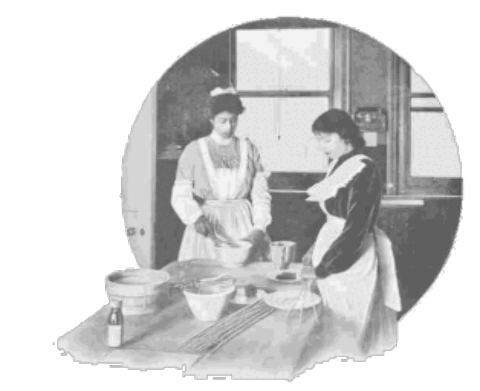
It should be mentioned that our present photograph does not show about 20 feet length of the Shipping Department behind, and to the right of the position from which the photograph was taken. On the left of the picture is seen the door of the Agents' room-a conveniently-fitted office for the use of the London Selling Force-whilst still more to the left would he the exit to the side street, where broughams and vans are loaded.
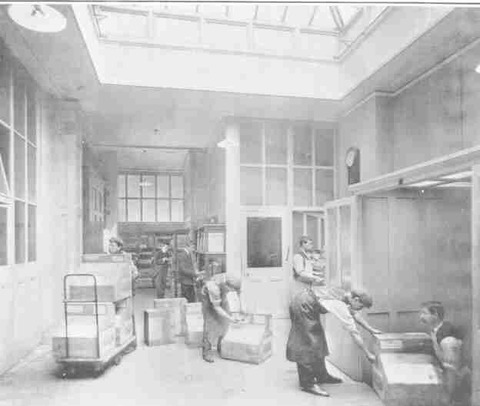
On the extreme right, not shown in the picture, is the goods entrance, from an alley-way leading into a back street. On the right-hand side of our illustration is shown the goods lift communicating with the basement.
It will be seen that the department is beautifully lighted by a very large skylight. When a large shipment of Registers is received from the Docks, say a couple of hundred cases, ample room is found here for storing them. In the portion of the department not shown in the photograph, shelves are fitted round the walls to contain Registers needed by the London Selling Force using broughams or buggies.
Having these Registers ready at hand, with supplies for each, no delay occurs in loading up for the day's work. In the Centre of the picture a door will be seen, leading through to the electric passenger lift, communicating with all floors. It is also another means of access to the Showrooms.
Welfare
We give one or two little illustrations of Factory methods which we have so far been able to adopt at the London Offices. It will be readily understood that the comparatively small staff here necessitated a very moderate commencement.
A spacious Bath and Dressing Room is placed at the disposal of the young women. (This facility was unique to NCR and was available for hot or cold baths, by prior arrangement, in the company's time. At that time only one house in 300 had a bathroom)
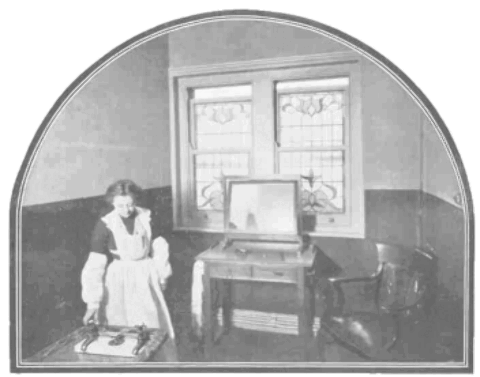
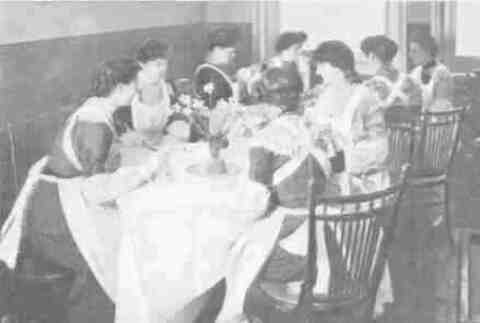
One of our views shows a corner of the Young Women's Tea Room, an institution which is much appreciated during the recess given on the Company's time for taking tea each afternoon.
John H. Patterson
In 1908 JH Patterson again visited England. This time he stayed for two years. One of his first actions was to remove Mr Saxe as managing director. He had brought with him from America, Mr Charles Palmer a former British Army Gymnastic Instructor and later an assistant to the famous Eugene Sandow in his physical training school. John H in his constant search for perfect health had undergone a prolonged fasting cure. The fast may have cured his original problem but it nearly killed him. It was then that John H. went to the Sandow school and was put under the care of Palmer. He derived such benefits from his treatment that he engaged him as his personal attendant at took him first to Dayton and then to London.
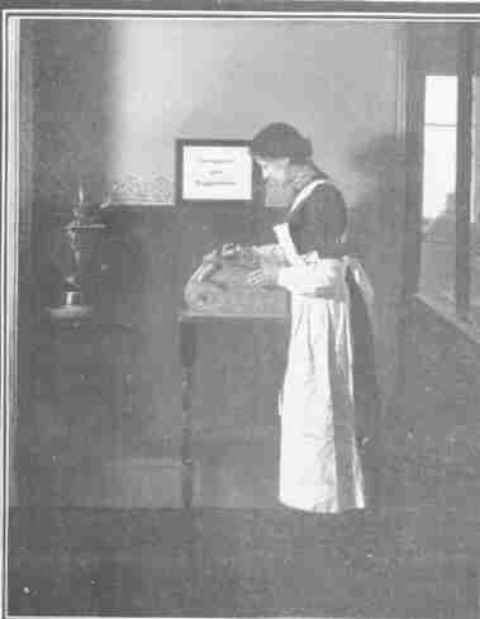
It goes almost without saying, that the suggestion box system is in active operation. Many useful suggestions come to hand from time to time, and a series of money prizes ranging from 10/- to £2 each are offered for the best suggestions during each half-year.
Patterson made Charles Palmer the new Managing Director of the British organisation. His only qualifications for the job were his magnificent physique his knack of managing J.H.Patterson and on occasions an overwhelming gift of the most forceful army language.
In 1910 a new managing Director was appointed by Patterson, a Mr Henry C. Banwell. He was an Englishman who had emigrated to America in his early teens and had been in charge of the office in the first department store to install National Registers. Shortly after appointing Banwell, Patterson returned to Dayton taking Palmer with him.
Banwell was a man of forceful character and untiring energy. He took charge of the British Organisation at a critical time and managed it on a profitable basis for the next 19 years.
Early after his appointment Banwell took over the building adjoining the Tottenham Court Road Office to provide extra rooms and allow improvements to the existing building. On the top floor was a much larger personal letter department, a new agent's office and a shipping department.
On the second floor a brand new office housed the experimental department later known as research and development. next to this was the mechanical department and the "Betterments Department".
On the ground floor a new enlarged showroom was established and a new convention hall built on the American pattern and part of the ground floor became a garage to house NCR's new fleet of motor vehicles.
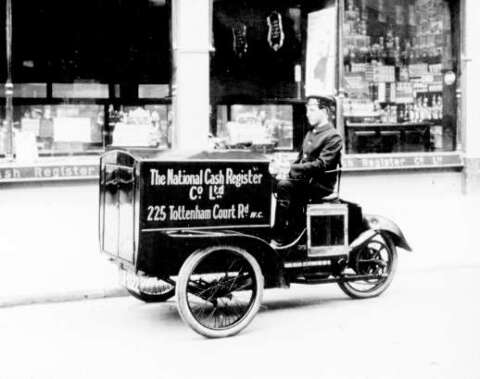
The Garage
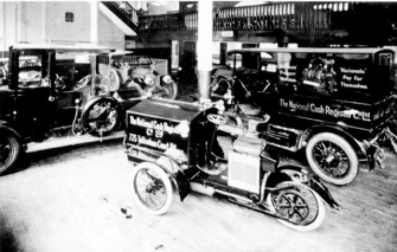
The Delivery Man
1913 and 1914
1913 and 1914 were boom years for NCR in Great Britain but war in 1914 brought a change in fortune. John H. Patterson was in Berlin when Germany invaded Belgium in 1914 and managed to escape on one of the last trains to leave Germany. Dismissal notices were handed out to all the European staff.
The Dayton production fell because the European shipments lessened. The export of machines to Britain did not stop until 1916 and it was only with the entry of America into the war that stopped production of cash registers when the factory changed over to munitions production. All brass and bronze was required for the production of shell cases and it was this that prompted the change from the famous brass machines cabinets to sheet steel.
1921 The class 2000 accounting machine with thirty totalisers was introduced. Models were marketed up to 1973, making the 2000 the longest-lived of any NCR products. Frederick Beck Patterson, John Patterson's son, was named president, and his father, chairman, a year before the founder's death in 1922.
In 1926 NCR became publicly owned and was incorporated in the State of Maryland.
In 1929 The Ellis Adding - Typewriter Company was acquired. The class 3000 accounting machine was developed from the Ellis model having a keyboard to input a narrative description of entries, as well as adding, subtracting and printing features. A new showroom was built at Tottenham Court Road to show off these machines.
1931 Colonel Edward A. Deeds returned to NCR to become chairman of the board. He had left the company in 1915 to help manage Delco, a company formed with Charles Kettering. He also co-founded the Wright Airplane Company with Orville Wright and others.
In 1931 the National Cash Register Co took over the Remington Cash Register Company and at one stroke removed a competitor and gained additional top class salesmen.
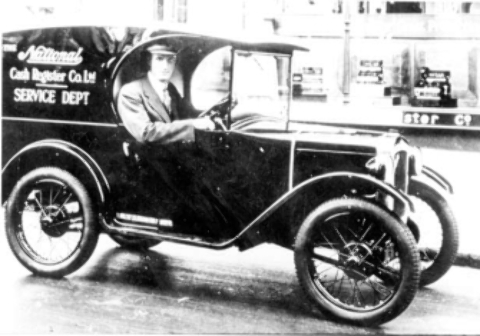
In 1932 the company bought the first vehicle for the mechanics. This was an Austin 7 D type van, named because of the shape of the side windows.

The British NCR Organization 1936